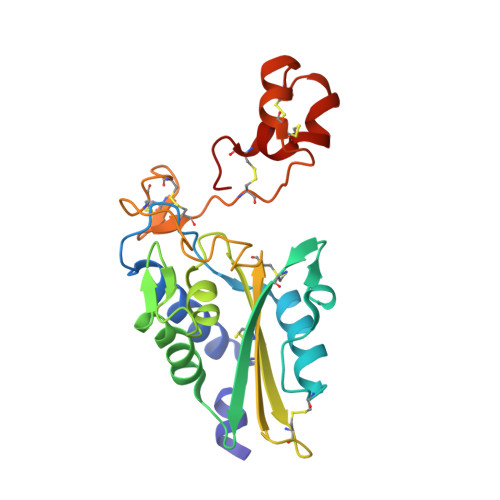Crystal structure of a CRISP family Ca2+ -channel blocker derived from snake venom.
Shikamoto, Y., Suto, K., Yamazaki, Y., Morita, T., Mizuno, H.(2005) J Mol Biol 350: 735-743
- PubMed: 15953617
- DOI: https://doi.org/10.1016/j.jmb.2005.05.020
- Primary Citation of Related Structures:
1WVR - PubMed Abstract:
The cysteine-rich secretory proteins (CRISPs) are widely distributed in mammals, reptiles, amphibians and secernenteas, and are involved in a variety of biological reactions. Here we report the crystal structure of triflin, a snake venom derived blocker of high K(+)-induced artery contraction, at 2.4A resolution. Triflin consists of two domains. The first 163 residues form a large globular body with an alpha-beta-alpha sandwich core, which resembles pathogenesis-related proteins of group-1 (PR-1). Two glutamic acid-associated histidine residues are located in an elongated cleft. A Cd(2+) resides in this binding site, and forms a five-coordination sphere. The subsequent cysteine-rich domain adopts a rod-like shape, which is stabilized by five disulfide bridges. Hydrophobic residues, which may obstruct the target ion-channel, are exposed to the solvent. A concave surface, which is surrounded by these two domains, is also expected to play a significant role in the binding to the target receptor, leading to ion channel blockage. The C-terminal cysteine-rich region has a similar tertiary structure to voltage-gated potassium channel blocker toxins, such as BgK and ShK. These findings will contribute toward understanding the functions of the widely distributed CRISP family proteins.
Organizational Affiliation:
Department of Biochemistry, National Institute of Agrobiological Sciences, Kannondai 2-1-2, Tsukuba, Ibaraki 305-8602, Japan.















